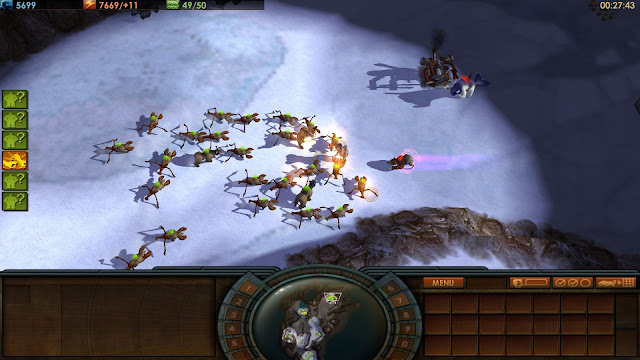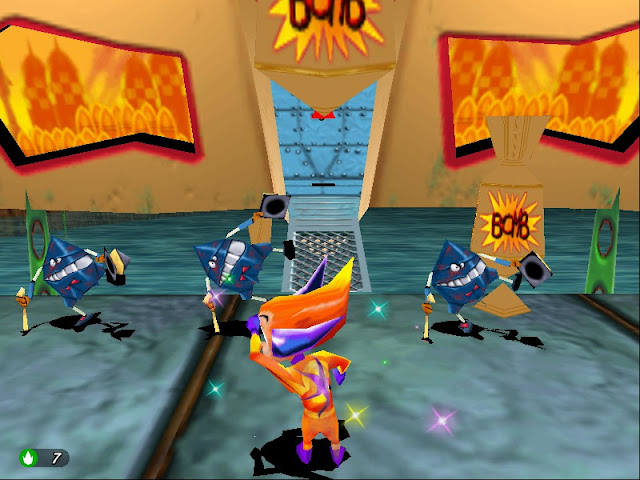Impossible Creatures Review | Who's a good abomination of nature?
I am fascinated by the 6th generations of video games, it was an era of experimentation and risk, many developers were creating projects with bizarre ideas or unseen concepts.
One of such games was Impossible Creatures, with the premise of "what
if you could create your own units based on mixtures of two animals?".
Aesthetics

|
These looks were the |
The graphics are what they are, child of 2003, with the usage of saturated textures and blocky models. I don't think that they have aged as gracefully as other games from this era though, the models are too rough to be appealing, even for the standards of that age. Unless you have nostalgia for this kind of looks, like I do, you are not going to enjoy the view.
Animation is another area the game lacks behind, when the creatures run, the limbs move in a robotic artificial way, and when they stay still, they don't have any kind of idle animations, they are static apart for maybe some tail movement.
This is likely due to the quirk of the game, since the animations have to account for an exponential amount of combinations between animals, so I guess I can't really complain too much.
In short, time has not been kind to the graphics, but the sound design is decent.
Game Mechanics

|
Mixing animals is the core idea of the game |
The title is a real time strategy game with a twist: instead of playing with a pre-defined set of units, the player is able to make their own, mixing the parts of two animals of choice to create a unique combination with traits from both of them. In the campaign, you must gather the DNA samples from the wandering animals, after that you are going to get access to the laboratory in which the mixing can start. You can choose between two of any animal, and once chosen, you then must decide which parts to grant to the new creation for maximum efficiency of your strategy.
The game does a good job displaying the information the player wants to see during this phase, like the damage and abilities of both options, plus the eventual costs. Mixing and matching stuff becomes an engaging mechanic fast and it keeps evolving thanks to the variety of new animals added, like when aquatic units are unlocked and it becomes possible to create a hybrid that can walk on land and also swim.
It's a very cool mechanic with lots of potential, and some catches. The first one is the feeling of the units, they feel monotonous to command, because the mass and dimension of each one of them is overall the same, they are going to have similar pattern of movement, which by the way is very rough, the pathfinding is bad, I had to issue the same command multiple times just so they could move properly. The second one are the overall upgrades, instead of grating some new tool or ability, they focus on more generic stuff, like increasing health or attack damage, although due to the unique quirk of this game, it's understandable why this is the way it is.
Before moving to the base building, a note about the two heroes: Rex Chance and Lucy Willing. At the start, Rex is very fragile and the only thing he can do is gather the DNA from the wandering animals. As the adventures continues, he will unlock new abilities which are going to make him a good asset in the fights, like shooting poison darts that deal tons of damage, but take a long time to recharge. Lucy is a buffed henchman (the builders/gatherers of this game), she is capable to gather resource and build faster, later on she also gains the ability to "steal" enemies structure tech so that the player can build these new structures, and the ability to sabotage enemy structures, dealing a lot of damage over time.
Now back on track, for the production economy there are two resources: coal and energy. Coal is gathered by the deposits over the map and is limited, meanwhile energy is generated by the lighting rods and generators infinitely. The rods can be built anywhere, but the player can only have 4 of them, while the generators are technically limitless, but are in fact limited by the amount of geyser on the map, since one must be built over a geyser to function.
Structure wise, it's simple: there is the main lab (you lose immediately if it is destroyed) where henchmen are trained and technology levels are researched, a workshop used to gather resources away from the lab, 3 kinds of chambers for the 3 type of creatures you can create(ground, air and aquatic), two defensive structures (one for ground and one for air) plus a wall, 2 research structures (one for the creatures and one for the henchmen/buildings) and a helipad for a gyro copter. Of the bunch, the helipad is the most interesting. Once built, you can create a gyro copter that is going to be piloted by one of your henchmen and is going to have the same functions as a normal henchman, just with the extra ability to fly and transport one unit.
It can lead to some interesting strategies, like sneaking the copter behind the enemy lines to build a creature chamber for a surprise attack. Apart from this, the other structures are functional, without major flaws or praises.
As for the level design, all the maps take place on an island, meaning that theoretically it's possible to sneak around by water, but that is not possible since some parts have steep cliffs, unusable for amphibious attacks, and usually there are a lot of anti-air towers, making air assaults a too costly endeavor. This made me use almost exclusively ground units, which in some circumstances made the progress a slog.
Fortunately, the enemy design is bearable since all the creatures that are going to be faced can be recreated in the laboratory, as long as the player has the necessary DNA samples. While this didn't make them too frustrating to fight, it also didn't impress me, at least for the first half of the game, after that giants starts to appear and things start to evolve, until I realized that the giants have no unique perk, making them just big normal units to fight. Coupling that with a basic (and I'm pretty sure cheating) AI, it made the fights a bit tedious towards the end, not too much, I managed to beat the game in 16 hours, but still enough to make me feel slightly tired.
Summarizing, while not perfect due to an unoptimized level design and a basic AI, the unique mixing mechanic offered gives a twist to the gameplay in a way no other title has managed to replicate to this day.
Narrative

|
The most powerful weapon in fiction: common sense |
It's 1937, it's a quiet night when Rex Chance receives a letter from his long-lost father, Eric Chanikov, who has invited him to the islands where he has been exiled for years and "reveal the truth to him". As Rex reaches the insides of the laboratory where his father resides, he is attacked by unseen creatures and barely escapes, only to be cornered from more of these strange beasts. Their master, Upton Julius, owner of the islands and close associated of Rex's father, claims that these creatures are the product of the Sigma technology, a technique capable of mixing two incompatible animals into a new form. He has a nefarious scheme and needs Rex to accomplish it, but just as Rex is about to be captured, a woman comes to the rescue and saves Rex in the nick of time. She is Lucy Willing, colleague of Rex's father. It is up to them to stop Julius's plans and find out the truth about the Sigma technology.
From here the adventure starts, in the shoes of the two protagonists, Rex and Lucy. The premise itself is cool and gets most of the questions that come up answered, except for the final twist that I didn't understand fully. It's not the deepest narrative, but it gets the job done, it made me want to see what was going to happen.
This same feeling applies to the overall subjects of the main antagonist, they tend to have a modest personality without big shifts, once you see them once, you can pretty much expect what they are going to do or say. As for the two protagonists, they are not monotone, they do tend to change a little bit during the course of the campaign, showing some signs of change of hearth on some personal things during important situations.
There isn't a whole lot of world building, you get some answers and insights during the cutscenes, but that's it. Though, the villains do receive their backstories and a motivation to join Julius, so at least there is that.
In conclusion, the story serves its purpose for the play session, but it's not going to stick in your mind for too long.
Recommendation:
Impossible Creatures did not break the mold or create a new sub-genre in the strategy genre, but it had an interesting idea and run with it to a good degree of success.




Comments
Post a Comment